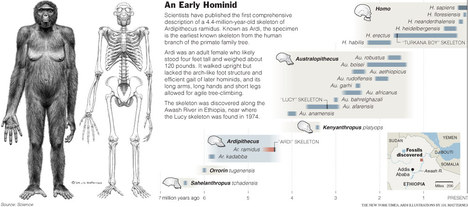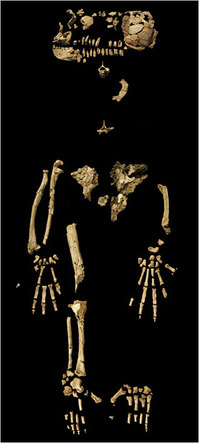 Source of graphic: online version of the NYT article quoted and cited below.
Source of graphic: online version of the NYT article quoted and cited below.
(p. A1) Ardi, short for Ardipithecus ramidus, is the newest fossil skeleton out of Africa to take its place in the gallery of human origins. At an age of 4.4 million years, it lived well before and was much more primitive than the famous 3.2-million-year-old Lucy, of the species Australopithecus afarensis.
Since finding fragments of the older hominid in 1992, an international team of scientists has been searching for more specimens and on Thursday presented a fairly complete skeleton and their first full analysis. By replacing Lucy as the earliest known skeleton from the human branch of the primate family tree, the scientists said, Ardi opened a window to “the early evolutionary steps that our ancestors took after we diverged from our common ancestor with chimpanzees.”
. . .
(p. A6) Scientists not involved in the new research hailed its importance, placing the Ardi skeleton on a pedestal alongside notable figures of hominid evolution like Lucy and the 1.6-million-year-old Turkana Boy from Kenya, an almost complete specimen of Homo erectus with anatomy remarkably similar to modern Homo sapiens.
David Pilbeam, a professor of human evolution at Harvard University who had no role in the discovery, said in an e-mail message that the Ardi skeleton represented “a genus plausibly ancestral to Australopithecus” and began “to fill in the temporal and structural ‘space’ between the apelike common ancestor and Australopithecus.”
Andrew Hill, a paleoanthropologist at Yale University who was also not involved in the research, noted that Dr. White had kept “this skeleton in his closet for the last 15 years or so, but I think it has been worth the wait.” In some ways the specimen’s features are surprising, Dr. Hill added, “but it makes a very satisfactory animal for understanding the changes that have taken place along the human lineage.”
The first comprehensive reports describing the skeleton and related findings, the result of 17 years of study, are being published Friday in the journal Science. Eleven papers by 47 authors from 10 countries describe the analysis of more than 110 Ardipithecus specimens from a minimum of 36 different individuals, including Ardi.
The paleoanthropologists wrote in one of the articles that Ardipithecus was “so rife with anatomical surprises that no one could have imagined it without direct fossil evidence.”
A bounty of animal and plant material — “every seed, every piece of fossil wood, every scrap of bone,” Dr. White said — was gathered to set the scene of the cooler, more humid woodland habitat in which these hominids had lived.
This was one of the first surprises, said Giday WoldeGabriel, a geologist at Los Alamos National Laboratory, because it upset the hypothesis that upright walking had evolved as an adaptation to life on grassy savanna.
For the full story, see:
JOHN NOBLE WILFORD. “Fossil Skeleton From Africa Predates Lucy.” The New York Times (Fri., October 1, 2009): A1 & A6.
(Note: ellipsis added.)
“A fairly complete skeleton of Ardipithecus ramidus, which replaced Lucy as the earliest known skeleton from the human branch of the primate family tree.” Source of caption and photo: online version of the NYT article quoted and cited above.


